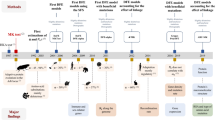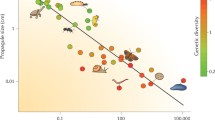Abstract
THE adaptive significance of the widespread protein polymorphism found in natural populations continues to be a central issue in population genetics1–3. Whether this variation is maintained by some form of balancing selection (the selectionist hypothesis) or by the stochastic interaction between selectively neutral mutations and genetic drift (the neutralist hypothesis) remains unclear. Also, evidence is accumulating that the simple electrophoretic separation of proteins detects a much smaller amount of the actual genetic variation present than had been assumed4–9. This has serious implications for much of the data used as evidence in the selection–neutrality controversy. If electrophoretic allozymes are actually large heterogeneous classes of alleles (that is, electromorphs10), then much of the most convincing data presented as evidence for the selectionist hypothesis may be illusory9. Therefore, methods are needed to distinguish between the selectionist and neutralist models without being dependent on detecting all or most of the genetic variation at a particular locus. I describe here a method meeting this criterion by using the relative rate of loss of duplicate gene expression to test the predictions of these two conflicting hypotheses. I report that the rate of loss for different proteins following tetraploidy in two independent groups of fish is positively correlated with the tendency for particular proteins to be polymorphic in natural populations of animals. This relationship is predicted by the ‘neutralist’ hypothesis of protein polymorphism and is in direct conflict with the predictions of the ‘selectionist’ hypothesis.
Similar content being viewed by others
References
Lewontin, R. C. The Genetic Basis of Evolutionary Change (Columbia University Press, New York, 1974).
Ayala, F. J. (ed.) Molecular Evolution (Sinauer, Sunderland, Massachusetts, 1976).
Sarich, V. M. Nature 265, 24–28 (1977).
Boyer, S. H. Nature 239, 453–454 (1972).
Bernstein, S., Throckmorton, L. & Hubby, J. Proc. natn. Acad. Sci. U.S.A. 70, 3928–3931 (1973).
Singh, R., Hubby, J. & Lewontin, R. Proc. natn. Acad. Sci. U.S.A. 71, 1808–1810 (1974).
Johnson, G. B. Genetics 83, 149–167 (1976).
Coyne, J. A. Genetics 84, 593–607 (1976).
Singh, R. S., Lewontin, R. C. & Felton, A. A. Genetics 84, 609–629 (1976).
King, J. L. & Ohta, T. Genetics 79, 681–691 (1975).
Ohno, S. Evolution by Gene Duplication (Springer, New York, 1970).
Comings, D. Nature 238, 455–457 (1972).
Kimura, M. & Ohta, T. Proc. natn. Acad. Sci. U.S.A. 71, 2848–2852 (1974).
MacIntyre, R. J. A. Rev. ecol. Syst. 7, 421–468 (1976).
Ohno, S. Animal Cytogenetics 4 : Chordata 1: Protochordata, Cyclostoma, and Pisces (Gebruder Borntraeger, Berlin, 1974).
Bogart, J. & Wasserman, A. Cytogenetics 11, 7–24 (1972).
Haldane, J. B. S. Am. Nat. 67, 5–19 (1933).
Nei, M. Nature 221, 40–42 (1969).
Nei, M. & Roychoudhury, A. K. Am. Nat. 107, 362–372 (1973).
Allendorf, F. W., Utter, R. M. & May, B. P. in Isozymes IV: Genetics and Evolution (ed. Markert, C. L.) 415–432 (Academic, New York, 1975).
Ferris, S. D. & Whitt, G. S. Nature 265, 258–259 (1977).
Spofford, J. B. Am. Nat. 103, 407–432 (1969); Brookhaven Symp. Biol. 23, 121–143 (1972).
Allendorf, F. W. Genetics 83, 1 (1976).
Powell, J. R. Evolut. Biol. 8, 79–119 (1975).
Ayala, F. J. Proc. Sixth Berkeley Symp. Math. Stat. Prob. VI., 211–236 (1972).
Johnson, G. B. Science 184, 28–37 (1974); in Molecular Evolution (ed. Ayala, F. J.) 46–59 (Sinauer, Sunderland, Massachusetts, 1976).
Kimura, M. & Ohta, T. Proc. natn. Acad. Sci. U.S.A. 72, 2761–2764 (1975); Nature 229, 467–469 (1971).
Allendorf, F. W. & Utter, F. M. Genetics 74, 647–654 (1973); Hereditas 82, 19–24 (1976).
Allendorf, F. W., Mitchell, N. J., Ryman, N. & Stahl, G. Hereditas (in the press).
Bailey, G. S., Wilson, A. C., Halver, J. E. & Johnson, C. L. J. biol. Chem. 245, 5927–5940 (1970).
Selander, R. K. & Johnson, W. E. A. Rev. ecol. Syst. 4, 75–91 (1973).
Author information
Authors and Affiliations
Rights and permissions
About this article
Cite this article
ALLENDORF, F. Protein polymorphism and the rate of loss of duplicate gene expression. Nature 272, 76–78 (1978). https://doi.org/10.1038/272076a0
Received:
Accepted:
Issue Date:
DOI: https://doi.org/10.1038/272076a0
- Springer Nature Limited
This article is cited by
-
Whole-genome duplication in teleost fishes and its evolutionary consequences
Molecular Genetics and Genomics (2014)
-
Bursts and horizontal evolution of DNA transposons in the speciation of pseudotetraploid salmonids
BMC Genomics (2007)
-
Evolution of genetic redundancy
Nature (1997)
-
Why are most mutations recessive?
Journal of Genetics (1993)
-
Chinook salmon NADP+-dependent cytosolic isocitrate dehydrogenase: Electrophoretic and genetic dissection of a complex isozyme system and geographic patterns of variation
Biochemical Genetics (1992)





